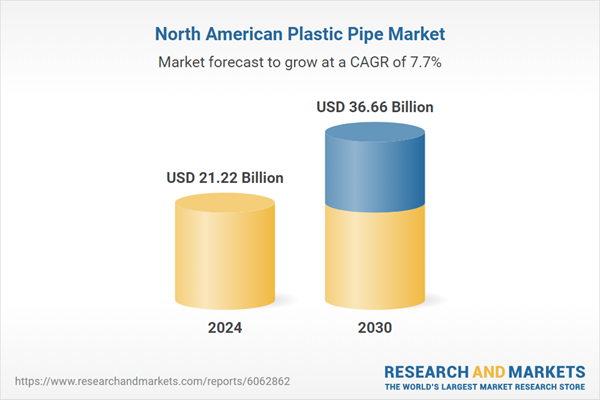Speak directly to the analyst to clarify any post sales queries you may have.
10% Free customizationThis report comes with 10% free customization, enabling you to add data that meets your specific business needs.
Their inherent flexibility, lightweight design, and ease of installation - facilitated by methods like solvent welding, heat fusion, and mechanical fittings - make plastic pipes particularly attractive for both residential and commercial infrastructure projects. Additionally, their smooth internal surfaces enhance flow efficiency, while their non-conductive and chemically resistant properties enable usage in environments where electrical hazards and chemical degradation are concerns.
Despite their advantages, selecting the appropriate type of plastic pipe remains essential to ensure optimal performance under specific application requirements and environmental conditions.
Key Market Drivers
Technological Advancements in Manufacturing Processes
Continued innovation in plastic pipe manufacturing has been a pivotal factor in the market’s expansion. Developments in extrusion technology, material science, and production techniques have resulted in products with improved strength, environmental resistance, and service life.Cross-linked polyethylene (PEX) pipes, for example, have seen widespread adoption due to their enhanced flexibility, thermal stability, and ease of installation, making them ideal for residential plumbing and radiant heating systems. Similarly, advancements in PVC pipe formulations have increased their durability and impact resistance, particularly in municipal water and wastewater infrastructure.
Installation efficiencies have also improved, with innovations in joining technologies reducing the need for intensive labor, which is especially beneficial in large-scale urban projects. The ability to produce pipes in a variety of shapes, sizes, and pressure ratings has further broadened their applicability across sectors such as agriculture, oil and gas, telecommunications, and chemicals.
Ongoing investment in R&D is expected to fuel future innovations, supporting the development of high-performance plastic piping solutions and solidifying their position as a reliable alternative to traditional piping materials.
Key Market Challenges
Environmental Impact and Recycling Limitations
One of the principal challenges facing the North American plastic pipe industry is its environmental footprint, particularly regarding waste management and recycling practices. Although plastic pipes are lauded for their longevity and cost-efficiency, concerns persist about their long-term environmental sustainability.Plastic piping materials such as PVC and PE are technically recyclable; however, recycling infrastructure across the region remains underdeveloped. Many recycling facilities lack the capacity to process plastic pipe waste effectively, and the complexity of sorting plastic materials often results in disposal via landfills.
Additionally, there is rising concern about microplastic pollution from degrading plastic products, along with environmental risks associated with certain chemical compounds used during manufacturing. While plastic pipes offer a more sustainable solution than metal alternatives due to their longer life span and lower maintenance demands, addressing their end-of-life impact is critical.
To mitigate these challenges, industry players are exploring the use of recycled or bio-based materials and investing in next-generation recycling technologies. Nevertheless, substantial progress in waste management systems and technological enhancements is needed to reduce the ecological impact of plastic piping solutions.
Key Market Trends
Rising Adoption of Cross-Linked Polyethylene (PEX) Pipes
A notable trend in the North American plastic pipe sector is the growing utilization of cross-linked polyethylene (PEX) piping systems. PEX has gained significant momentum in residential and commercial applications due to its superior flexibility, which reduces the number of fittings and joints required, thereby minimizing leak potential and improving system reliability.Its ability to withstand thermal expansion and contraction without cracking makes PEX particularly suitable for installations in colder climates, where freeze resistance is essential. PEX also exhibits low thermal conductivity, contributing to energy efficiency in both hot and cold water systems.
As the construction industry increasingly prioritizes sustainability and energy performance, the demand for PEX continues to rise. The material’s lightweight nature, ease of installation, and resistance to corrosion make it ideal for water distribution and radiant heating systems. This trend is especially evident in modern homebuilding, where PEX is becoming the preferred material for heating infrastructure.
Key Market Players
- Kruger Industries
- JM Eagle Inc.
- Westlake Pipes & Fittings
- Michigan Pipe & Valve
- Fabco Plastics
- WL Plastics
- National Pipe & Plastic Inc.
- ZQ Steel Group Co. Ltd.
- Diamond Plastics Corporation
- Astral Pipe
Report Scope:
In this report, the North America Plastic Pipe Market has been segmented into the following categories, in addition to the industry trends which have also been detailed below:North America Plastic Pipe Market, By Type:
- Chlorinated Polyvinyl Chloride Pipes
- Cross Linked Polyethylene Pipes
- Polypropylene Random Copolymer pipes
- Others
North America Plastic Pipe Market, By End Use:
- Residential
- Commercial
- Industrial
- Infrastructure
- Agriculture
North America Plastic Pipe Market, By Country:
- United States
- Canada
- Mexico
Competitive Landscape
Company Profiles: Detailed analysis of the major companies present in the North America Plastic Pipe Market.Available Customizations:
With the given market data, the publisher offers customizations according to a company's specific needs. The following customization options are available for the report.Company Information
- Detailed analysis and profiling of additional market players (up to five).
This product will be delivered within 1-3 business days.
Table of Contents
Companies Mentioned
- Kruger Industries
- JM Eagle Inc.
- Westlake Pipes & Fittings
- Michigan Pipe & Valve
- Fabco Plastics
- WL Plastics
- National Pipe & Plastic Inc.
- ZQ Steel Group Co. Ltd.
- Diamond Plastics Corporation
- Astral Pipe
Table Information
| Report Attribute | Details |
|---|---|
| No. of Pages | 123 |
| Published | April 2025 |
| Forecast Period | 2024 - 2030 |
| Estimated Market Value ( USD | $ 21.22 Billion |
| Forecasted Market Value ( USD | $ 36.66 Billion |
| Compound Annual Growth Rate | 7.7% |
| Regions Covered | North America |
| No. of Companies Mentioned | 10 |









